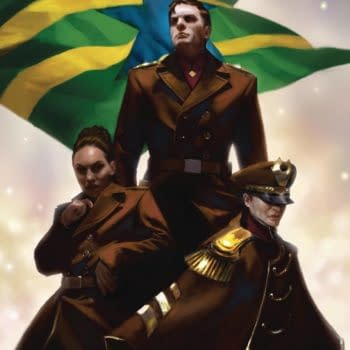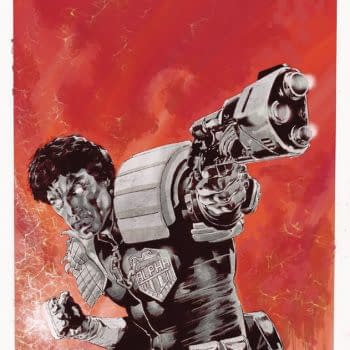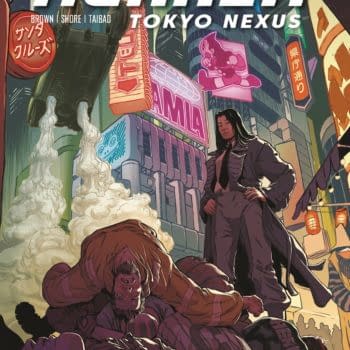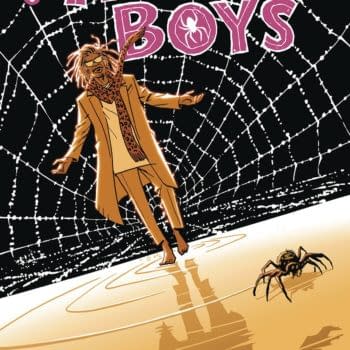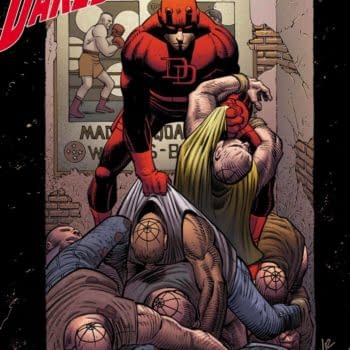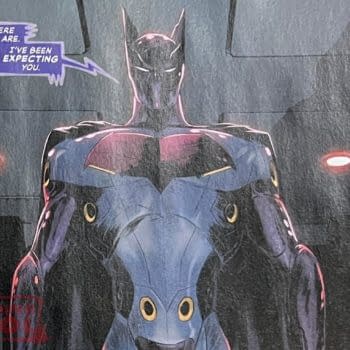Posted in: Comics, Recent Updates | Tagged: Big Game Hunters #1, boom studios, Comics, dc comics, entertainment, Escape From New York, gail simone, idw, joe hill, jok, ray bradbury, Secret Six, Shadow Show, Shon C. Bury
Thor's Comic Review Column – Big Game Hunter, Secret Six, Escape From New York, Shadow Show
This Week's Reviews:
Big Game Hunter #1
Secret Six #1
Escape from New York #1
Shadow Show #1
Big Game Hunters #1 (Space Goat Productions, $0.99)
By Cat Taylor
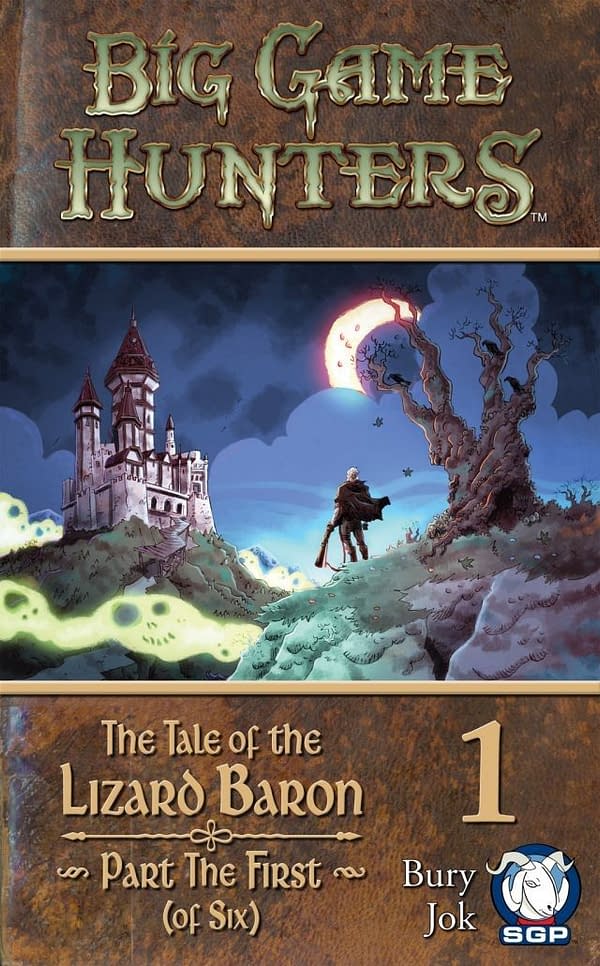
The plot synopsis sounded pretty interesting: a group of monster hunters in the Victorian Age on missions to eradicate all of the classic creatures of "myth". In this issue their prey is a troll (not one of the internet commentators of the modern age, but the old fairy tale kind that lived under bridges and ate billy goats). I always hope that the first issue of a series featuring multiple characters will give me a brief introduction to the personalities and motivations of each person while teasing some secrets to be revealed later. None of that happened in this issue though. What did happen was that we met a team of monster hunters led by an old guy with a big gun named Quinn. His team consists of an even older guy who seems to be some kind of scientist, a really big guy, a woman, and one or two others, and that's about all that we learned about them. So, at this point I have very little interest in these characters. I still like the general concept but their conquest of the troll seemed remarkably easy and unexciting, and the lead-in to the next issue didn't feel essential or particularly captivating.
On a more positive note, although lacking the writing chops of Alan Moore, this book's author, Shon C. Bury, created a story with an atmosphere that could be a very small part of League of Extraordinary Gentlemen. It would be nice to see future issues reach a level of intrigue and complexity somewhat close to what Moore did with his stories, even though that's asking a lot. However, it's a bit confusing to me that a tale with such a fun concept could have such a bland first issue. I wouldn't be surprised if this was written by a rookie, but Bury is an experienced and accomplished comic book writer who has been in the business since the 1990s and has written for Marvel and DC among others. He's also apparently a successful entrepreneur given that he has several ventures happening through his own company, Space Goat Productions. As a result, I feel justified holding Bury to higher standards than I saw here.
On an even more positive note, the art by Jok and Estudio Haus is similar to work by such luminaries as Kevin O'Neill and Mike Mignola and therefore greatly elevates the quality of this book. In fact, the art far exceeds the quality of the writing but I hope that this issue is just a slow start that will pick up in the future. At this moment though, that's the most complimentary thing I can say about Big Game Hunters.
Cat Taylor has been reading comics since the 1970s. Some of his favorite writers are Alan Moore, Neil Gaiman, Peter Bagge, and Kurt Busiek. Prior to writing about comics, Taylor performed in punk rock bands and on the outlaw professional wrestling circuit. During that time he also wrote for music and pro wrestling fanzines. In addition to writing about comics, Taylor tries to be funny by writing fast food fish sandwich reviews for Brophisticate.com. You can e-mail him at cizattaylor@hotmail.com. At the time of writing this review, it was Thanksgiving here. What holiday was it where you live?
Secret Six #1 (DC Comics, $2.99)
By Graig Kent

The original series was borne from the '60's espionage craze that saw The Man From U.N.C.L.E., Mission Impossible, Get Smart and more propagate across the four-channel airwaves. The '80's series likewise adopted the fantasy-tinged espionage of that decade's action series like The Equalizer, Airwolf, MacGyver, Knight Rider and the like. There was a "mission of the week" feel, with the ongoing thread of the team questioning "who is Mockingbird?" There was an element to Mockingbird that had the characters doing the right thing, but under a certain level of duress. They were basically blackmailed into being spies.
The Gail Simone relaunch of the Secret Six in the late 2000's was a soft relaunch of the Suicide Squad through rebranding, via a six-issue mini-series. No longer were the titular six pedestrians, instead Simone took familiar DC villains and put them under the thumb of a mysterious Mockingbird (who turned out to be Lex Luthor). When the Secret Six went to series, the characters were mercenaries working under their own moral compasses (which routinely caused conflict between characters), and frequently put them at odds with other villains of the DCU. It became one of DC's consistently best written, most violent, frequently ingenious titles up until its cancellation shortly before Flashpoint rebooted the DCU. A new Secret Six in The New 52, with Simone again at the helm, is an intriguing proposition no matter how you feel about The New 52.
Undoubtedly, Secret Six would be another assembly of villains, but part of what made Simone's first Six run so intriguing was its sense of character history and its weight within the context of larger DCU history. There were ties to Ra's Al Ghul and Apokolips, and past failures of the many long lived (if mostly underserved) characters would often come back to haunt them (forcing Simone into redefining them). A New 52 version wouldn't have the same sense of history and the weight of the characters would expectedly be far, far different.
Joined by artist Ken Lashley (with ink assists by Drew Geraci and colors from Jason Wright), Simone's cast isn't a bunch of deeply-seeded also-rans but a sextet of familiar, quasi familiar, and wholly unfamiliar faces. In fact, at this stage I'm not quite sure who all the potential Six are.
Catman is back. After Simone utterly redefined him in her original Six run from goofy Batman D-list rogue to dangerous heartthrob, it's natural that he would return almost indistinct from when we first saw him in the first Secret Six mini-series. The only difference is the relevance of Catman overcoming his D-list status and how that elevated him as a character; he starts off kind of badass here. The first third of the book is dedicated to his capture, showing both his competencies, how dangerous he is, and his weakness. Upon awaking from his capture, he finds he's in an underwater pen with six strangers, when a mysterious voice (Mockingbird, no doubt) and a gigantic billboard give the group an ultimatum, do as he asks or one of them will die. The others are Black Alice, Talon, Porcelain, the Ventriloquist, Strix, and Big Shot. Naturally, as you can count, that's seven, and the book's called Secret Six, so one of these people are going to meet an untimely end, likely next issue.
At this stage, it feels far more like Saw with super-villains than the mercenary team or band of superspies we have seen of the brand in the past. There's no way it's going to continue in that measure for too long (using superhero comics to tell a closed-room torture-porn story seems kind of a waste if that's all it strives to be), so while the story so far hasn't presented anything fresh, I'm at least intrigued by where it could possibly be going. Plus, I have faith in Simone, having been down this road before with her. She's earned the goodwill. Part of the fun of her previous Six series was in watching her build up the characters as well as forge the most functional team (which frequently meant some characters had to go, and in the worst possible ways), so hopefully at least part of this series will be much the same thing without treading familiar ground.
Lashley's style here takes on a strong Denys Cowan vibe, with an abundance of crosshatching and looser line, particularly in the backgrounds. It's not that Lashley was the cleanest artist before but his figures and settings used to be tighter, a lot more defined, so it's an unexpected departure. I wonder if Wright's washed out watercolors contribute to the Cowan feel, as it's kind of a throwback to the 1980's The Question series Cowan illustrated. Art and color together give the book a distinct feel, certainly from most of The New 52 at this point, so whilst it's not unwelcome, I'm not quite sold on it yet. The "Snakes And Ladders" cover from Dale Eglesham and Wright is definitely eye-catching, and teases what will underpin the series for the near future: "What is the secret?"
Hey, I'm curious.
Graig Kent just finished posting his first novel, Quarter City, to Wattpad. It's set in alternate universe,framed around society's reactions to beings with super powers, the extreme actions of the most powerful Enhanced in particular. You might like it. Graig tweets stuff @thee_geekent and he does various other things in other places. He'd rather you read the book than look that stuff up, though.
Escape from New York #1 (Boom! Studios)
By Bart Bishop
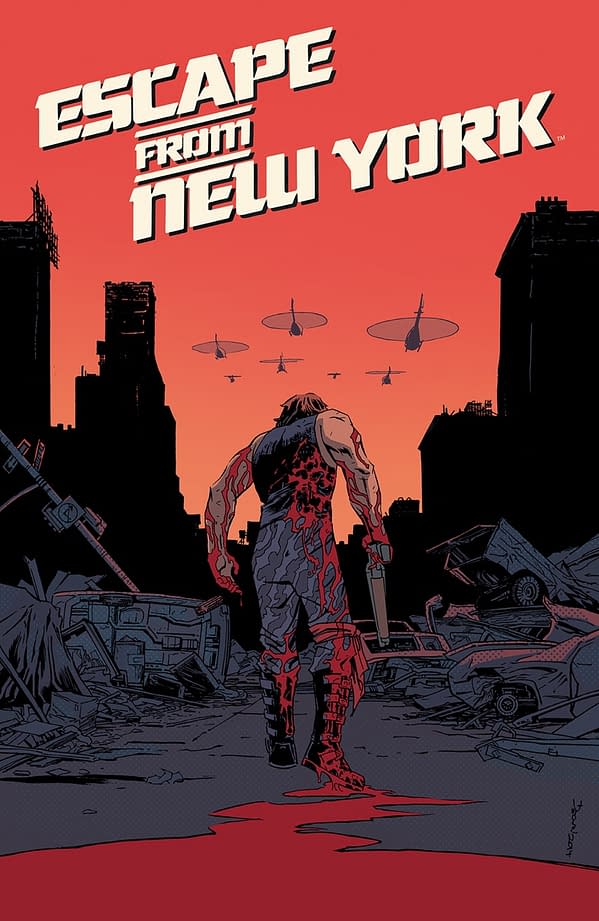
That's the premise Christopher Sebela and Diego Barreto run with in Boom! Studio's new Escape from New York ongoing series. This is actually the third time a comic translation has been attempted, with Marvel's The Adventures of Snake Plissken one shot in 1997 and CrossGen's John Carpenter's Snake Plissken Chronicles miniseries in 2003. Although this latest attempt lacks Carpenter's sharp ear for satire and comic touch, it's breathlessly paced and loaded with action, and the end serves as a provocative mirror to the movie while promising juicy jabs at today's headlines.
Much like the aforementioned Chronicles this first issue picks up immediately where the movie left off. Snake flees from the police and falls in with a group of religious fanatics on their way to Florida. Turns out Florida has seceded from the United States, although the government has covered this up, and is supposedly the only bastion of freedom left in the world. The leaders are The Twins, who may or may not be psychic. Snake goes along with the zealots for a bit until they shoot up a gas station, forcing the ex-soldier's pang of conscience to kick in. He takes them out but continues to Florida, where he's forced into a hazing gauntlet reminiscent of the New York prison's registration antechamber from the movie. Of course he makes it through but immediately picks a fight with the first figure of authority he runs into, because that's Snake for you, always getting into trouble.
Snake is a delicate character to pull off, and the world he inhibits is a fine balance. Even Carpenter himself went off the rails with his sequel Escape from L.A., ratcheting the tone up too far into absurdity. Still, even that unfortunate attempt had its moments, especially the ending, and Snake himself was never betrayed or played as a joke. Sebela succeeds here, keeping Snake gruff and no-nonsense, with quip at the ready and finger on the trigger. The world around him, however, isn't quite pushed enough. There's some nice radio talking heads that try to justify the tape playing music at the end of the movie, saying the president was waving a white flag to the Soviet Union with the tunes, but Sebela just isn't having enough fun. Certainly he must be taking aim at Florida's tarnished reputation lately and let's hope future issues tackle such issues as Stand Your Ground and race, but for an introduction this is a bit toothless.
Barreto's art is similar in style to Brian Churilla, which is appropriate considering Boom! started publishing a continuation of Big Trouble in Little China recently. Barreto's riff on Kurt Russell is a bit bulkier than the relatively lean actor was in his prime, but exaggeration is key in these properties, not photorealism. That way lays the travesties of the Gregs, Horn and Land. Large chunks of the comic are devoted to nearly silent action, and Barreto is up to the task, especially a rather clever sequence that has a soldier falling from the sky vertically on the left next to a succession of panels on the right. Still he is rather sparse in detail, instead riding hard on cartooning that lacks the grit the movie had. These renditions would, ironically, be more appropriate in something along the lines of L.A., playing up the hyperbolic possibilities, but it does get the job done.
Another instance of unnecessary continuations, but at least Snake lends himself to getting into trouble. There's certainly a retro-futurism going on here that's fascinating, with cassettes and the Soviet Union existing alongside advanced technology, but let's hope Sebela digs a little deeper with a character that risks superficiality if not handled with the right touch.
Shadow Show #1 (IDW Publishing)
By Bart Bishop
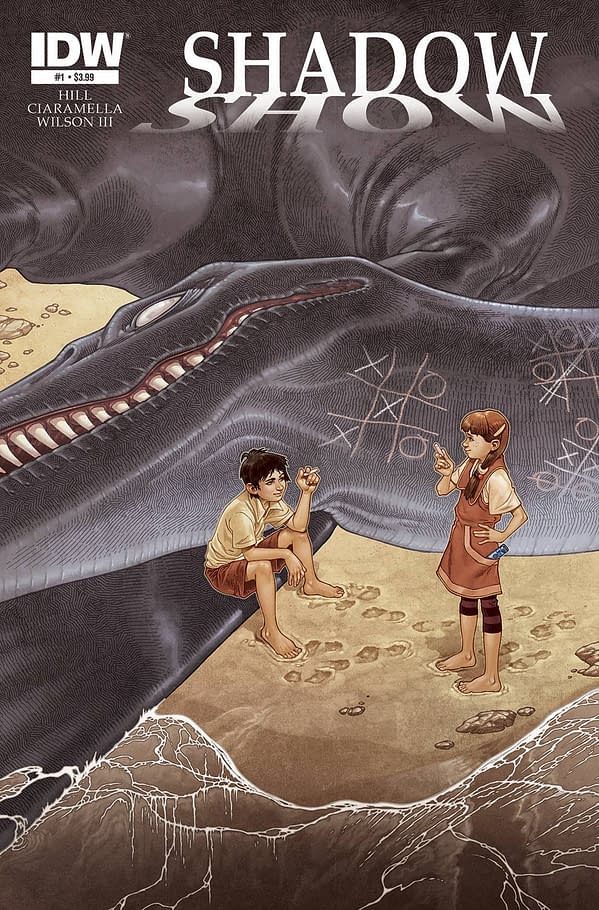
First up is Hill's "By The Silver Water of Lake Champlain", with the adaptation written by Jason Ciaramella and art by Charles Paul Wilson III. As the introduction makes clear, Bradbury had a strong relationship with comic books over the years, first being unceremoniously "borrowed" from by EC Comics and then later jumping in head first to the medium. It's appropriate, therefore, that this series brings things full circle, with this first story a melancholy meditation on childhood wonder and the crushing reality of bildungsroman.
Taking place in the titular setting, this brief but evocative tale follows Gail, an older woman living in a cottage on the lake that flashes back to a childhood incident. She's an artist that wants nothing more than to be left to her sketches, but her pushover father is forced by an unseen but volatile mother to send Gail and her sisters out the door to play with the Cradox brothers, including Joel whom Gail may or may not have a crush on. Joel has found something "squashy," and while the younger children run off he and Gail investigate what turns out to be a dead creature very much in the vein of the Loch Ness Monster. Their discovery quickly leads to visions of money for their find resulting in a future of independence, freedom and adventure. Joel wins Gail's good graces by carving "Gailasaurus" onto the beast's skin, but while she runs off to retrieve her father Joel is seemingly eaten by the monster's mate. In the present day, Gail is still haunted by that day, stuck ruminating on what might have been.
Ciaramella has a difficult task here. Not only does he need to stay true to the voice of Hill, whom he's adapting, but also Bradbury, the inspiration for the style and tone of the piece. Ciaramella does a commendable job, balancing a succession of reveals and drawing out the mystery almost to the last page. Why does the elderly Gail peer out the window so longingly? Why is young Gail so hesitant to play with Joel, who is first introduced brandishing a pocket knife he received for his birthday? I admit I suspected at first that the knife was a Chekhov's Gun device, set up so early on so that it would be inevitably used by the end, but I dreaded it was a hint at a coming act of violence.
It turns out that Joel is not only harmless but a likable character that Gail quickly warms to, although I will say the elderly Gail reminiscing about him needed to be more earned: wouldn't it be more appropriate if they had been sweethearts, rather than their only becoming true friends immediately before Joel's disappearance? As for the bildungsroman, this story is a coming-of-age tale, and Ciaramella deftly handles the collision of childhood aspiration and the cruel fatalism of growing up, really heightening the sadness as Gail screams at the lake, "You can't take him like this!" as if she's yelling at the universe itself.
Wilson, meanwhile, has an appropriately cartoony style that draws the reader into a false sense of security. Take, for instance, the withholding of keeping Gail's mother "offscreen". Only her toxic words spill onto the page, but Gail's pained expressions and the dumpy desperation of her father pleading with her to take the children out communicate everything that needs to be known about the mother. The colors, handled by Wilson while accompanied by Jeremy Mohler, are soft pastels reminiscent of water colors, soothing but also cold and droning. There's a particularly beautiful shot as Gail first encounters the brothers with Joel about to stomp on a line of action figures, the background thick with fog, that is a marvel of perspective, making the humans appear as giants as the colors blur into each other. The splash page of Gail and Joel also draws to mind children's books, so the following pages of Joel's disappearance and the lumbering shadow in the water slinking away are all the more shocking.
An existential look at grief without closure, Shadow Show #1's "By The Silver Water of Lake Champlain" is a thrilling kick-off for this series. It stays true to its roots, paying tribute to Bradbury and doing Hill justice, while standing alone as its own haunting tone poem.
Editor and teacher by day, comic book enthusiast by night, Bart has a background in journalism and is not afraid to use it. His first loves were movies and comic books, and although he grew up a Marvel Zombie he's been known to read another company or two. Married and with a kid on the way, he sure hopes this whole writing thing makes him independently wealthy someday. Bart can be reached at bishop@mcwoodpub.com.










